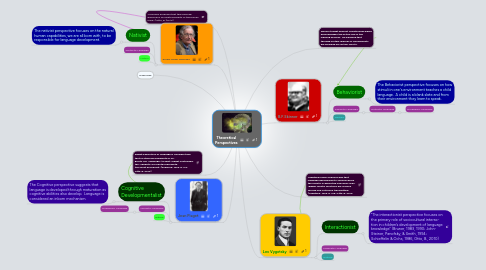
1. Piaget’s definition of language is narrower than that of other psychologists or lin- guists. For “language” to exist, Piaget contended, the “capacity for mental representa- tion must be present” (Brainerd, 1978, p. 110, Otto, B, 2010)
2. "Chomsky proposes that this universal grammar is an innate property of the human mind." (Otto, B. (2010).
3. Avram Noam Chomsky
3.1. Nativist
3.1.1. The nativist perspective focuses on the natural human capabilities, we are all born with, to be responsible for language development.
3.2. Syntactic Language
3.3. Nature
4. Jean Piaget
4.1. Cognitive Developmentalist
4.1.1. The Cognitive perspective suggests that language is developed through maturation as cognitive abilities also develop. Language is considered an inborn mechanism.
4.2. Semantic Language
4.2.1. Morphemic Language
4.3. Nature
5. New node
6. Skinner taught operant conditioning which acknowledges the active role in the learning process. He believed that through certain rewards or punishments are followed by certain results.
7. Vygotsky’s basic premise was that language development is influenced by the society in which the individual lives: “higher mental functions are socially formed and culturally transmitted” (Vygotsky, 1978, p. 126, Otto, B, 2010.
8. B.F.Skinner
8.1. Behaviorist
8.1.1. The Behaviorist perspective focuses on how stimuli in one's environment teaches a child language. A child is a blank slate and from their environment they learn to speak.
8.2. Semantic Language
8.2.1. Syntactic Language
8.2.1.1. Morphemic Language
8.3. Nurture
9. Lev Vygotsky
9.1. Interactionist
9.1.1. "The interactionist perspective focuses on the primary role of sociocultural interac- tion in children’s development of language knowledge" (Bruner, 1983, 1990; John- Steiner, Panofsky, & Smith, 1994; Schieffelin & Ochs, 1986, Otto, B., 2010)
